Consumer Price Index in NCR stays at 118.2 percent
The CPI in NCR this February 2023 stayed at its previous month’s level of 118.2 percent. On yearly basis, the CPI increased by 9.5 percentage points during the month from 108.7 percent in February 2022. The CPI in NCR consistently remained below the Philippines’ record which also settled at 121.4 percent in the past two consecutive months of 2023.
The CPI of 118.2 in February 2023 indicated that consumer prices, on average, had increased by 18.2 percent from the base year 2018. This can also be interpreted that a basket of commodities that can be purchased at PhP100.00 by an average Filipino household in NCR in 2018 can be bought at PhP118.2 in February 2023. (Figure 1)
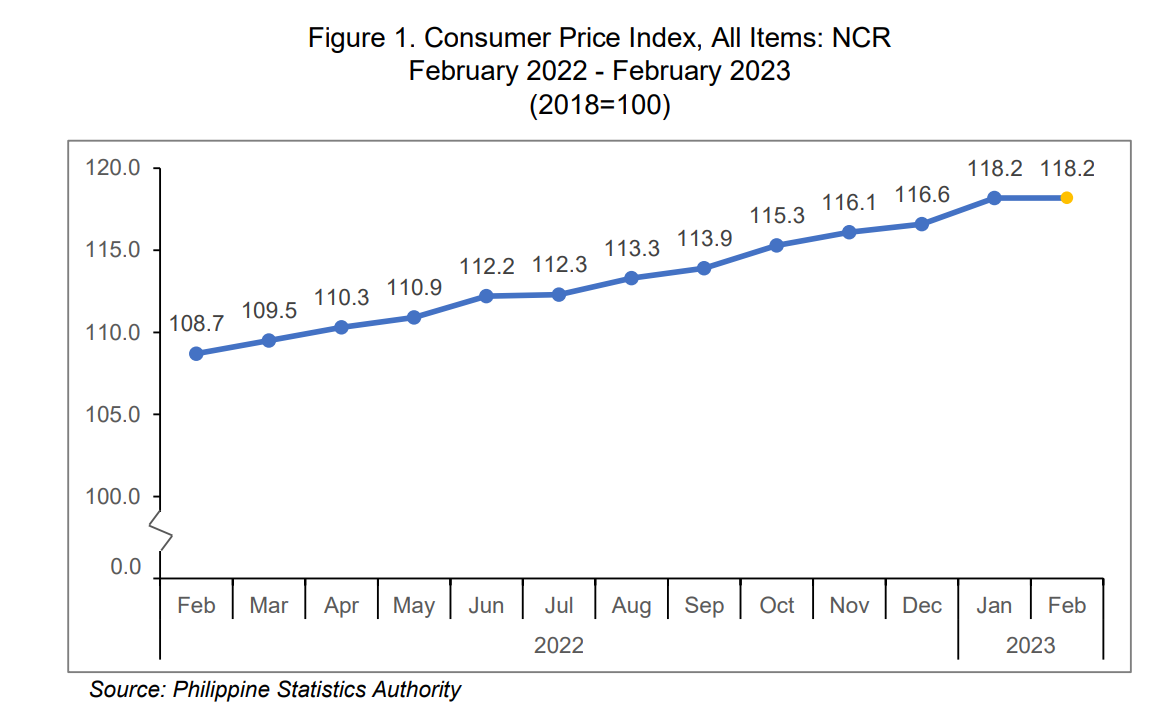
Across all regions, Region XII (SOCCSKSARGEN) joins with the Philippines and NCR with unchanged CPI in January and February 2023. On the other hand, the remaining 15 regions were almost split into two halves as seven (7) of the regions registered a decrease while eight (8) regions recorded an increase in CPI this month compared to January 2023. Among those regions that registered a decrease in CPI were Region VII (Central Visayas) with 116.8 percent, Bangsamoro Autonomous Region in Muslim Mindanao (BARMM) with 119.3 percent, and Cordillera Administrative Region (CAR) with 120.0 percent. These three (3) regions, together with the NCR, were all in the bottom four (4) regions with the lowest CPI. Likewise, among the regions that recorded an increase in CPI were MIMAROPA and Region V (Bicol Region) both with 126.7 percent and Region VI (Western Visayas) with 124.5 percent. These regions also comprised the top three (3) regions with the highest CPI in February 2023. (Figure 2)
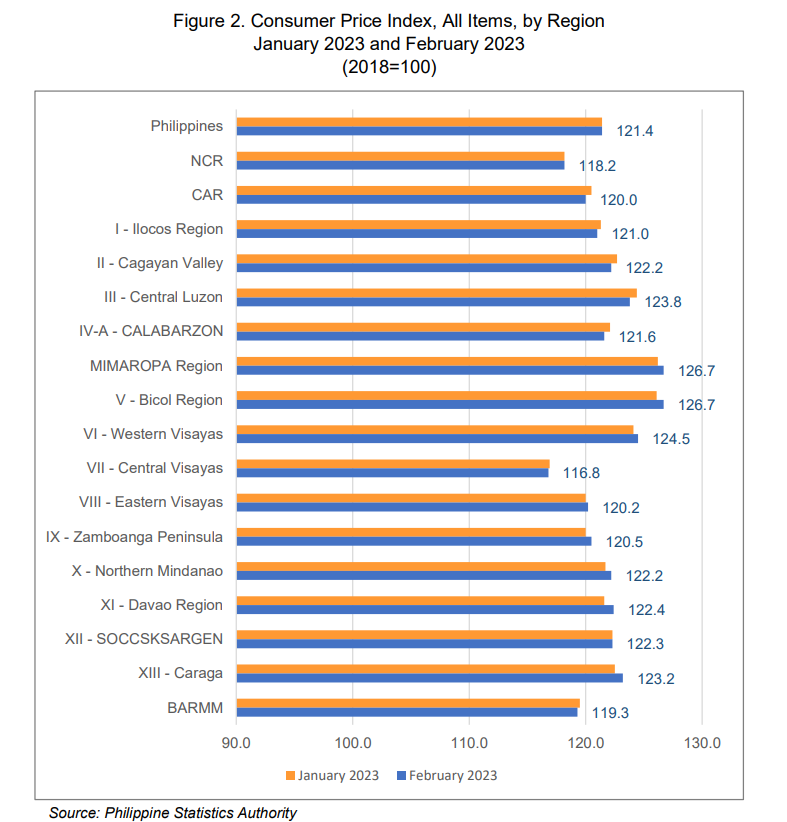
Inflation rate in NCR inch up by 0.1 percentage point
The inflation rate in NCR inched up by 0.1 percentage point as it reached 8.7 percent this February 2023 from 8.6 percent in the previous month. In February 2022, the inflation rate was lower at 1.9 percent. (Figure 3)
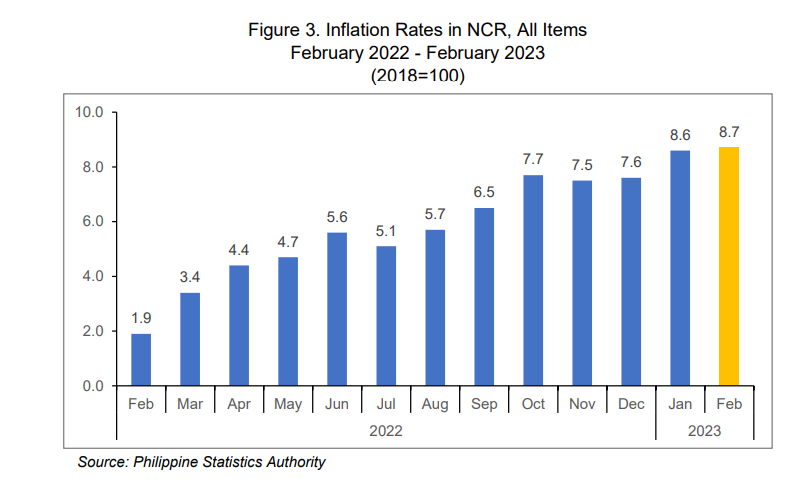
At the national level, the headline inflation rate for the Philippines slowed down to 8.6 percent in February 2023 from 8.7 percent in January 2023. Across all regions, Region VI (Western Visayas) registered the highest inflation rate at 10.8 percent followed by Region IX (Zamboanga Peninsula) and Region XI (Davao Region) with both 9.9 percent. On the other hand, regions with the lowest inflation rates were Region VIII (Eastern Visayas) at 6.3 percent, Cordillera Administrative Region (CAR) at 7.1 percent, and Region VII (Central Visayas) and Region XII (SOCCSKSARGEN) with both 7.4 percent. (Figure 4)

Index of housing, water, electricity, gas and other fuels is still the main driver of inflation in NCR
Similar to January 2023, the acceleration of the inflation rate in NCR this February 2023 was primarily driven by a higher year-on-year increase in the index of housing, water, electricity, gas and other fuels at 7.7 percent from 6.9 percent in the previous month. This was followed by furnishings, household equipment and routine household maintenance with an inflation rate of 6.9 percent, and the index of restaurants and accommodation services with a year-on-year growth rate of 10.9 percent.
Higher annual markups were also noted in the following commodity groups during the month:
a. Clothing and footwear, 3.2 percent;
b. Health, 2.2 percent;
c. Recreation, sport and culture, 3.8 percent; and
d. Personal care, and miscellaneous goods and services, 3.5 percent.
In contrast, lower annual increments during the month were observed in the indices of food and non-alcoholic beverages at 11.6 percent, alcoholic beverages and tobacco at 6.4 percent; and transport at 10.8 percent. The indices for the rest of the commodity groups continued to move at their respective rates in January 2023. (Table 1)
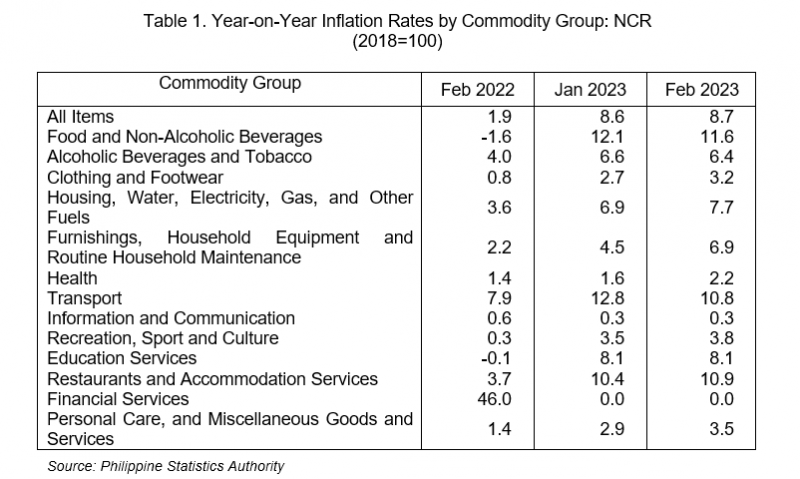
Inflation of food slows down to 12.2 percent
Food inflation slowed down to 12.2 percent in February 2023 from 12.7 percent in the previous month. The slower food inflation was primarily brought about by lower annual markup in the index of vegetables, tubers, plantains, cooking bananas and pulses at 40.8 percent this month from 51.9 percent in January 2023. Other food commodity groups that contributed to slower food inflation were the following:
a) Rice, 0.5 percent;
b) Corn, 18.2 percent; and
c) Meat and other parts of slaughtered land animals, 6.0 percent.
On the other hand, higher annual hikes were noted in the indices of the following food commodity groups during the month:
a) Flour, bread and other bakery products, pasta products, and other cereals, 13.0 percent;
b) Fish and other seafood, 10.3 percent;
c) Milk, other dairy products and eggs, 15.9 percent;
d) Fruits and nuts, 21.2 percent;
e) Sugar, confectionery and desserts, 28.7 percent; and
Ready-made food and other food products n.e.c., 14.3 percent. (Table 2)
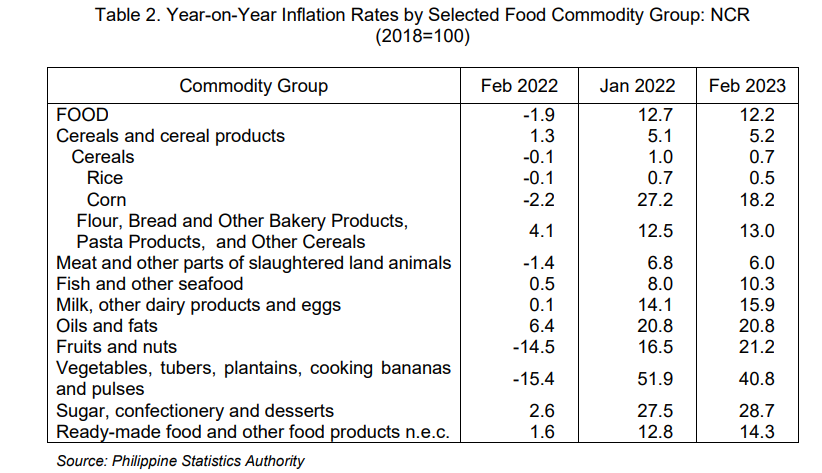
Purchasing Power of the Peso (PPP) remains at 0.85
The PPP is a measure of the real value of the peso in a given period relative to a chosen reference and is computed by getting the reciprocal of the CPI and multiplying the result by 100. The PPP is inversely related to the CPI thus an increase in the CPI will result in a decrease in the PPP.
The PPP in NCR remained at 0.85 in February 2023. This means that a peso in 2018 was worth 85 centavos in February 2023. The PPP in February 2022 was higher at 0.92. (Figure 5)
SGD.
PACIANO B. DIZON
Regional Director
TECHNICAL NOTES
Consumer Price Index
The Consumer Price Index (CPI) is an indicator of the change in the average retail prices of a fixed basket of goods and services commonly purchased by households for their day-to-day consumption relative to a base year.
Components of the CPI
a. Base Period
This is a reference date or simply a convenient benchmark to which a continuous series of index numbers can be related. Since the CPI measures the average changes in the retail prices of a fixed basket of goods, it is necessary to compare the movement in previous years back to a reference date at which the index is taken as equal to 100. The present series of CPI uses 2018 as the base period or base year.
b. Market Basket
Market basket refers to a sample of goods and services commonly purchased by the households.
The commodities included in the 2018-based CPI market basket are the modal
commodities which were considered as the most commonly purchased/availed of commodities by the households. The composition of the market basket was determined based on updating the 2012 basket using the results of the 2021 Survey of Key Informants (SKI). In NCR, a total of 760 commodities are included in the market basket.
c. Weighting System
The weights for the 2018-based CPI were derived from the expenditure data of the 2018 Family Income and Expenditure Survey (FIES). The weight for each commodity/group of commodities is the proportion of the expenditure of the expenditure of commodity/group of commodities to the total national expenditure. The sum of the weights of the commodity groups at the national level is equal to 100.
Inflation Rate
The inflation rate is the annual rate of change or the year-on-year change in the Consumer Price Index.
Purchasing Power of the Peso
The Purchasing Power of the Peso (PPP) is a measure of the real value of the peso in a given period relative to a chosen reference period. It is computed by getting the reciprocal of the CPI and multiplying the result by 100.
